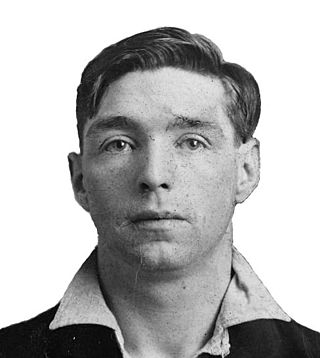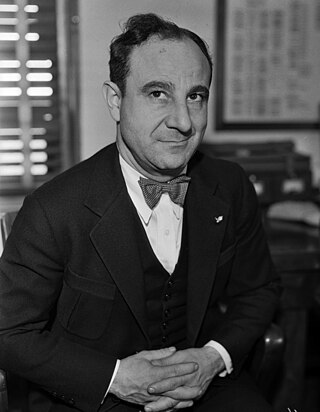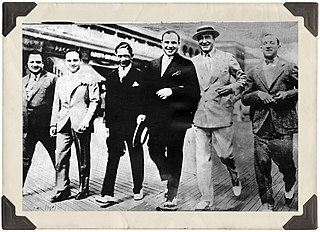
George Clarence "Bugs" Moran was an American Chicago Prohibition-era gangster. He was incarcerated three times before his 21st birthday. Seven members of his gang were gunned down and killed in a warehouse in the Saint Valentine's Day Massacre of February 14, 1929, supposedly on the orders of his rival Al Capone.

John Donato Torrio was an Italian born-American mobster who helped build the Chicago Outfit in the 1920s later inherited by his protégé Al Capone. Torrio proposed a National Crime Syndicate in the 1930s and later became an adviser to Lucky Luciano and his Luciano crime family.
The Valley Gang was an Irish-American street gang in Chicago, Illinois during the early 20th century, which ultimately made the transition to organized crime and became a de facto extension of the Chicago Outfit under Al Capone.

Owen Vincent "Owney" Madden was a British-born gangster of Irish ancestry who became a leading underworld figure in New York during Prohibition. Nicknamed "The Killer", he garnered a brutal reputation within street gangs and organized crime. He ran the Cotton Club in Manhattan and was a leading boxing promoter. After increased attention from law enforcement in New York, Madden moved to Hot Springs, Arkansas, in 1935, where he remained until his death from natural causes in 1965.
The Gustin Gang was one of the earliest Irish-American gangs to emerge during the Prohibition era and dominate Boston's underworld during the 1920s. The name "Gustin Gang" came from a street in South Boston ("Southie"), which was off of Old Colony Avenue, not from the name of any "members."

Jewish-American organized crime initially emerged within the American Jewish community during the late 19th and early 20th centuries. In media and popular culture, it has variously been referred to as the Jewish Mob, the Jewish Mafia, the Kosher Mob, the Kosher Mafia, the Yiddish Connection, and Kosher Nostra or Undzer Shtik. The last two of these terms are direct references to the Italian cosa nostra; the former is a play on the word for kosher, referring to Jewish dietary laws, while the latter is a calque of the Italian phrase 'cosa nostra' into Yiddish, which was at the time the predominant language of the Jewish diaspora in the United States.

The Atlantic City Conference held between 13–16 May 1929 was an historic summit of leaders of organized crime in the United States. It is considered by most crime historians to be the earliest organized crime summit held in the US. The conference had a major impact on the future direction of the criminal underworld and it held more importance and significance than the Havana Conference of 1946 and the Apalachin meeting of 1957. It also represented the first concrete move toward a National Crime Syndicate.
The Broadway Mob was a New York bootlegging gang during Prohibition. Although headed by Joe Adonis, the gangs day-to-day operations were handled by Charles "Lucky" Luciano and Frank Costello as well as financially backed by Arnold Rothstein. During Manhattan's bootleg wars, Rothstein would bring in the Bugs and Meyer Mob, led by Meyer Lansky and Benjamin "Bugsy" Siegel, to protect alcohol shipments.
Harry "Nig Rosen” Stromberg was a Philadelphia mobster who was a major organized crime figure on the east coast with influence as far as Atlantic City, Baltimore and Washington, D.C.
Daniel J. "Danny" O'Leary was an Irish Philadelphia mobster involved in bootlegging who, a rival of Maxie "Boo Boo" Hoff throughout Prohibition, would struggle for dominance among the many gangs of Philadelphia's underworld. His death, only six days after his participation in the gangland slaying of Hugh "Hughie" McLoon, would mark the beginning of gang wars during the late 1920s eventually leading to a Special August Grand Jury investigating corruption and influence of organized crime in the city.
Polish-American organized crime has existed in the United States throughout the 20th and 21st centuries. Although not as well known as Italian, Irish, Russian mafias, the Polish Mob has a presence in many urban Polish American communities.
Max "Big Maxie" Greenberg (1883–1933) was an American bootlegger and organized crime figure in Detroit, Michigan, and later a member of Egan's Rats in St. Louis. He oversaw the purchasing of sacramental wine from Orthodox rabbis, then allowed under the Volstead Act, which were sold to bootleggers in the St. Louis–Kansas City, Missouri area during Prohibition. He was also associated with mobsters in this particular method of acquiring illegal liquor including Waxey Gordon, Meyer Lansky and Arnold Rothstein.

Charles Dean O'Banion was an American mobster who was the main rival of Johnny Torrio and Al Capone during the brutal Chicago bootlegging wars of the 1920s. The newspapers of his day made him better known as Dion O'Banion, although he never went by that first name. He led the North Side Gang until 1924, when he was shot and killed, reportedly by Frankie Yale, John Scalise and Albert Anselmi.
The Lanzetta Brothers, also known as the Lanzetti Brothers due to an incorrect spelling used by newspapers, was a group of six brothers who ran bootlegging operations in Philadelphia and possibly Atlantic City.
Ignatius "Frank Pius" Lanzetta was born in Philadelphia, Pennsylvania in 1903. Ignatius had five other brothers, with whom he formed the bootlegging and drug trafficking Lanzetta Brothers gang. He and his brothers were also called "the Lanzetti brothers" due to newspapers relying on incorrect information.
Leo Lanzetta was born in Philadelphia, Pennsylvania in 1895. Leo had five other brothers, with whom he formed the bootlegging and drug trafficking Lanzetta Brothers gang. He and his brothers were also called "the Lanzetti brothers".

Max "Boo Boo" Hoff was an ex-boxer who later became a bootlegger and gambler.

Nucky Johnson's Organization was a corrupt political machine based in Atlantic City, New Jersey that held power during the Prohibition era. Its boss, Enoch "Nucky" Johnson, coordinated the Organizations's bootlegging, gambling, racketeering, and prostitution activities.
John Gilbert Finiello was an agent of the Bureau of Prohibition who was killed during a September 19, 1930 raid on the Rising Sun brewery in Elizabeth, New Jersey. Born in Italy, Finiello was a naturalized immigrant and decorated veteran of World War I who had a reputation for honesty and courage. He had previously turned over a $10,000 bribe intended to avert a raid on another distillery. When he was recognized during the raid he was shot by at least eight gunmen.








